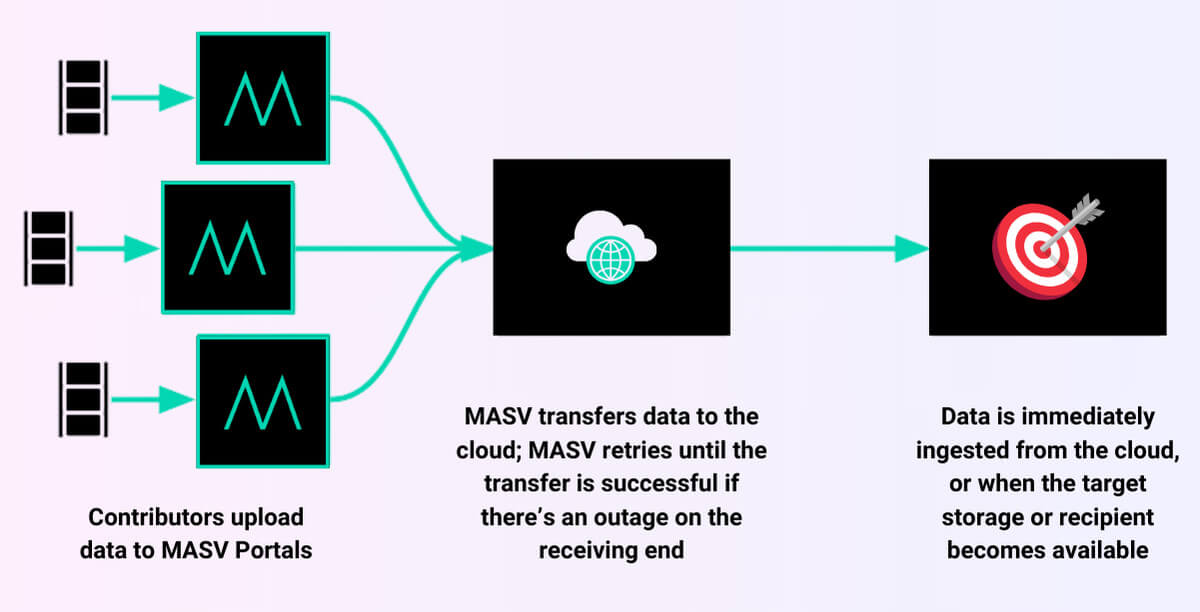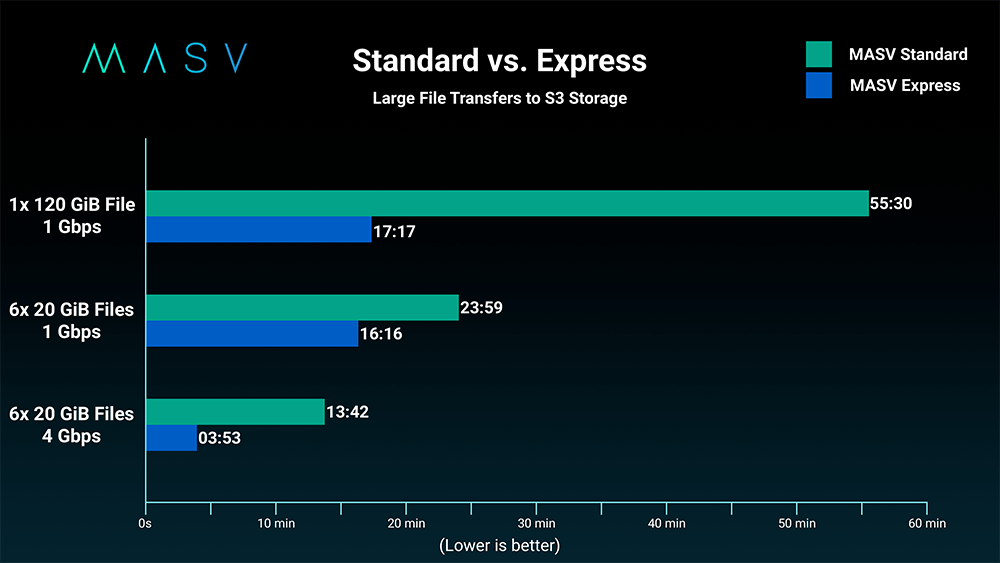Peek under the hood of enough file transfer services and you’ll likely notice there are two main ways of transferring files over the internet: P2P file sharing and store-and-forward (also known as relay-based transfer) over the cloud.
But what exactly do we mean by those terms? And which methodology – point-to-point or store-and-forward – is most effective for busy professionals who need to reliably transfer large files on a deadline without curling up in a ball and weeping?
In this post, we dive into the pros and cons of each method – and why store and forward file transfer is far more reliable, secure, and easier to set up and use without downgrading on speed. We’ll also detail how MASV’s newest file movement innovation, MASV Express, stacks even greater performance advantages onto this foundation of reliability. Let’s get to it.
Table of Contents
The Most Reliable File Transfer
Need ultra-reliable file transfer that just works? Get MASV.
Point-to-Point vs. Store-and-Forward: What’s the Difference?
Several notable differences exist between P2P (point-to-point) technology (not to be confused with peer to peer file sharing, which uses the combined bandwidth of all nodes in a network) and store-and-forward file transfer platforms.
What is point-to-point file transfer?
A P2P file sharing program is traditionally an on-premises system that moves files from point A to point B along your available bandwidth. Both sender and recipient need to install desktop software, creating a direct path between the two that allows them to transfer files via a server-to-server method.
In a P2P file sharing program, files are shared directly between endpoints with no buffer zone or middle hop in between – which may seem intuitively faster, but in reality, P2P doesn’t provide faster transfer speeds and will fail in case of an outage on the receiving end.
What is store-and-forward file transfer?
Store-and-forward shared files, on the other hand, are first sent to the cloud before going to the recipient.
Store-and-forward file transfer can match or even exceed the speeds of a P2P network, but with an added twist: Their two-hop nature means they’re often far more reliable. That’s because in case of an outage on the recipient side, files are securely stored in the cloud and delivered as soon as systems are back online.

P2P File Sharing vs. Store-and-Forward: Which is Best?
Both ways of sharing files have advantages, but one in particular makes store-and-forward file transfer a far more reliable method. Let’s explore what we mean by that.
P2P
First, the good: P2P solutions such as Aspera and Signiant Media Shuttle can achieve very fast file transfer speeds.
On the downside, however, they typically require complex hardware (such as a central server and other computing resources) and software installations, which can require hours of time from both the sender and recipient. Files shared within a local network typically don’t need a central server.
- To share files externally, however, P2P systems also usually require firewall and other configurations and the opening of ports, which adds more setup time and can be a security risk.
- Along with complicated setup, their complex user interfaces often necessitate training and tutorials (and sometimes hours of troubleshooting) for casual users to send files, which is just annoying.
- Because they often utilize on-premises hardware, P2P file sharing offers more centralized control compared to other services.
But one of the most impactful ways P2P file sharing software can fail users is when a recipient’s storage or compute instance goes offline, or storage runs out of space. When that happens, shared files to that recipient fail and must be restarted – resulting in lost time, low productivity, and extreme frustration on the part of your collaborators sending files.
Store-and-forward
Store-and-forward file transfer can match or even exceed the speeds of P2P systems with no decrease in file transfer turnaround time.
- Senders can utilize their full bandwidth during uploads without any throttling if the receiver has slower download speeds.
Because these systems are browser-based, they typically don’t require IT to set up. And their simplified interface is easy for users to spin up and start sharing files out of the box (without the time suck of sitting through training and tutorials).
But maybe their greatest benefit is their reliability: Store-and-forward file transfer creates a buffer zone between a sender and recipient, so if there is an outage or storage runs out of space on the receiving end, the issue doesn’t propagate down to your users. In our case, MASV holds the files in our secure container until they’re ready to be downloaded.
- This method relies on accelerated cloud infrastructure and provides a safe harbor between point A and point B, without sacrificing performance.
- Senders can securely upload files without failure on their end, even if there is a temporary issue with point B, alleviating frustration – and improving cost effectiveness when working with freelancers or others who spend unnecessary time retrying file uploads.
Users can continue to upload files without having to retry or babysit file transfers (and without you paying them to do so). In case of an outage on the recipient’s end, all files are retained in the cloud and are sent when the target storage becomes available.

OK, But Why Can’t Files Just Go Straight To Their Destination?
We often get questions about store-and-forward file transfer around turnaround time, cost, and security. And we’ve got answers to those questions.
Is P2P file transfer faster than store-and-forward?
P2P software uses a direct connection but both methods can achieve similarly fast speeds – with some store-and-forward based systems, like MASV, able to hit a sizzling 10Gbps. Advanced features allow recipients to start accessing files as they upload, significantly reducing wait times and delays in time-sensitive projects (more on this below).
That’s a big deal for content owners and streaming platforms who often receive finished files just a few hours before go-live time, and where every minute counts.
Additionally, because some store-and-forward file sharing platforms (like MASV!) offer one-to-many automated file transfers and global scale out of the box, organizations don’t waste time transferring the same file multiple times to hot and cold storage for editing and archival purposes. One upload can send files to multiple destinations automatically.
💡 Read More: Boost Efficiency With a One-to-Many Upload Workflow
Isn’t it cheaper and faster for users to send files directly to my storage bucket?
It’s true that users of a store-and-forward system pay for data egress from the cloud. But that’s the case no matter which cloud storage you use, and store-and-forward platforms like MASV typically offer cheaper egress than most other cloud providers.
- There’s also the issue of geography. An organization with unlimited resources could deploy multiple storage buckets in multiple regions, to ensure low latency transfers no matter where files are sent from.
- But deploying multiple cloud buckets requires a highly technical team of cloud engineers provisioning a ton of infrastructure in different regions, configuring your buckets, and keeping each of them secure, patched, and up-to-date – which can get expensive in a hurry (and takes a lot of time).
Organizations who try to save money by taking this route almost always end up spending more, with degraded performance to boot.
Isn’t it more secure for users to send files directly?
P2P file sharing systems may seem more secure, but the reality is that they’re often subject to potentially devastating vulnerabilities that have led to significant data breaches – especially when systems are self-hosted and often not updated and patched in a timely manner.
- Store-and-forward file sharing software like MASV is cloud native, which means all updates and patches are performed for all users by the provider in minutes.
- MASV uses strong encryption on all files at rest and in flight, along with internal ISO 27001 security controls and SOC 2 compliance for airtight data protection.
MASV is also a Gold Shield member of the MPA’s Trusted Partner Network (TPN) vendor roster, which uses third-party assessors to evaluate a vendor’s security measures in line with MPA best practices, to alleviate any security concerns. MASV also does not permit copyright infringement, illegal file sharing, or the unauthorized use of copyrighted material on our network.
How long do my files stay in the cloud?
Unlike P2P software, organizations who share files have full control over how long files are retained in a store-and-forward file transfer system’s cloud. Depending on your requirements, files can be retained for weeks, months, years, or deleted immediately.
MASV Express: Store-and-Forward on Steroids
MASV’s latest product drop, MASV Express, takes the store-and-forward model and injects it with fire for even greater performance, while still retaining the benefits of a store-and-forward system.
Built on the same store-and-forward platform customers around the world have come to rely on for fast, scalable, and secure file delivery, MASV Express moves files from origin to the destination without first needing the complete file in MASV’s secure container, accelerating file transfer turnaround times by as much as 3.5X.

With MASV Express, files start downloading as soon as the first bytes of the file begin their upload – improving performance even more while retaining the reliability and other advantages of store-and-forward by still sending files to the MASV cloud.
This is ideal for live sports and other live broadcast use cases, where speed-to-air is paramount. Teams can start cutting video into highlight clips as soon as a clip begins uploading to their storage bucket.
MASV: Store-and-Forward File Transfer More Reliable Than P2P File Sharing
MASV is a store-and-forward file sharing service that’s much easier to set up and use than P2P sharing, and leverages Amazon Web Services (AWS) global cloud infrastructure to provide the most secure, reliable, and accelerated file transfer possible.
It’s like a superhighway where files get on at the nearest on-ramp – an AWS data center – and travel at accelerated speeds to the offramp closest to the recipient, with no file size limits.
- But most importantly, unlike a P2P program, MASV protects against recipient outages and other potential file transfer failures by retaining files in our cloud and completing the transfer as soon as the recipient’s storage is back online.
- This alleviates frustration for users trying to send you files, while lowering costs for organizations who don’t need to pay collaborators to retry file transfers over and over.
- It does this without downgrading performance by utilizing a sender’s full bandwidth, without needless throttling if a recipient has a slow connection.
MASV’s new Express feature, which allows recipients to begin downloading files while they’re still being uploaded, adds even greater performance to file sharing workflows while retaining the benefits of store-and-forward.
Sign up for MASV for free and give it a try — your partners and collaborators will almost certainly thank you for it, and you won’t need to pay them to babysit and retry failed transfers. It’s a win-win.
Stop Babysitting Your File Transfers
With MASV’s ultra-reliable store-and-forward file transfer system, you just need to send files once and move on with your day.